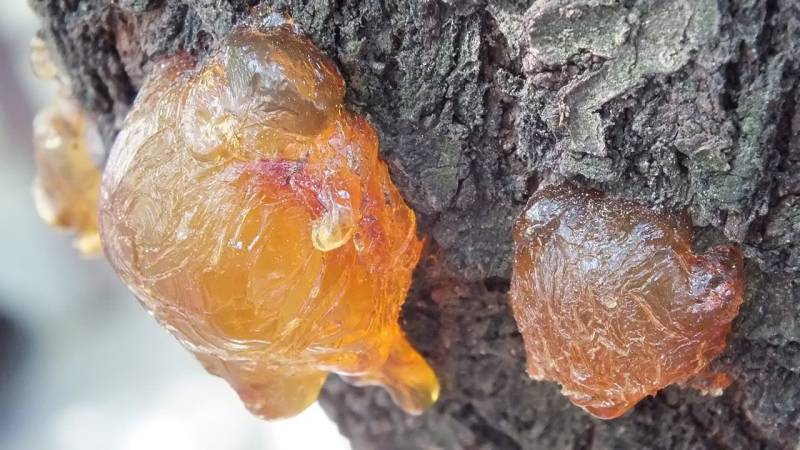
resin
Substantiv/Nomen
Meaning
Resin is a sticky substance that is naturally produced by certain trees, such as pine trees. In the context of survival, bushcraft, and outdoor activities, resin is a valuable resource with multiple uses. It can be collected from trees and used as a fire starter, as it is highly flammable. Resin can also be used to make glue, sealant, and waterproofing material for shelters and equipment. Additionally, it has medicinal properties and can be used as a natural adhesive for wound closure. Resin is a versatile and essential material for anyone venturing into the wilderness.

Examples
„I love using resin in my bushcraft projects. It's a versatile material that can be used for making glue, waterproofing items, and even starting fires. Resin is a sticky substance that is secreted by trees, and it can be found in abundance in the wilderness.“
„When I'm out in the wild, I always collect resin from pine trees. It's a valuable resource that can be used for many purposes.“
„One of my favorite uses for resin is making natural glue. I simply heat up the resin until it becomes liquid, then I apply it to the surfaces I want to bond together. It dries quickly and creates a strong and durable bond.“
„Resin is also great for waterproofing items. I often use it to seal the seams of my homemade shelters and to protect my gear from moisture. It forms a protective barrier that keeps water out and ensures that my belongings stay dry.“
„In addition to its adhesive and waterproofing properties, resin is also highly flammable. I always carry a small container of resin with me as a fire starter. It ignites easily and burns hot, making it an excellent tinder for starting a fire in any weather conditions.“
„Resin is truly a survivalist's best friend. Its versatility and abundance in nature make it an invaluable resource for any outdoor enthusiast. Whether you need to make glue, waterproof your gear, or start a fire, resin is the go-to material for all your bushcraft needs.“
Origin
The word "resin" originates from the Latin word "resina," which means "resin" or "pitch." Resin has its roots in ancient civilizations, where it was used for various purposes, including as a natural adhesive, waterproofing agent, and in the production of varnishes and incense.
Throughout history, resin has been sourced from various trees and plants, such as pine, fir, and cedar. The process of extracting resin involves making incisions in the tree bark, allowing the sticky substance to flow out and harden over time.
In modern times, resin continues to be valued for its versatile properties. It is commonly used in the production of adhesives, coatings, and composites. Additionally, resin is a popular material in crafts, jewelry making, and woodworking.
As a survival enthusiast, resin can be a valuable resource in the wild. It can be used as a fire starter, as it is highly flammable and burns for a long time. Resin can also be used to create makeshift glue or sealant, making it a useful tool for repairing gear or constructing shelters.
Synonyms
Sap, Pitch, Gum, Rosin, Amber, Balsam, Lacquer, Varnish
Antonyms
Liquid, Non-adhesive, Non-resinous, Non-gummy, Non-tacky, Non-viscous, Non-sticky
Relatives
Sap, Tree, Pine, Amber, Pitch, Adhesive, Varnish, Extraction
Historical and cultural importance
Resin has a long history of cultural and historical significance. It has been used by various civilizations for thousands of years for its versatile properties and practical applications.
In ancient times, resin was highly valued for its use in embalming and preserving bodies in Egyptian mummification rituals. It was also used in the construction of ancient Egyptian tombs and temples, as it provided a durable and waterproof sealant.
Resin has played a crucial role in traditional medicine practices around the world. Native American tribes used resin from pine trees for its healing properties, using it to treat wounds, infections, and respiratory ailments. In Ayurvedic medicine, resin from the Boswellia tree, commonly known as frankincense, has been used for centuries to alleviate inflammation and promote overall wellness.
Resin has also been an important material in the creation of art and craftsmanship. In ancient Greece, resin was used as a varnish to protect and enhance the beauty of sculptures and pottery. It was also used as an adhesive in the construction of musical instruments, such as violins and guitars.
Today, resin continues to be widely used in various industries, including woodworking, jewelry making, and even in the production of adhesives and coatings. Its natural adhesive properties, durability, and aesthetic appeal make it a valuable material for both practical and artistic purposes.
More information about the term resin
What is Resin?
Resin is a natural substance that is produced by certain plants as a protective response to injury or infection. It is a sticky, viscous liquid that hardens over time, forming a solid material. Resin has been used by humans for thousands of years for various purposes, including as a natural adhesive, a waterproofing agent, and a material for crafting and construction.
Types of Resin
There are several types of resin, each with its own unique properties and uses. Some of the most common types include:
Epoxy Resin: Epoxy resin is a versatile and durable type of resin that is commonly used in various applications, such as coating surfaces, creating jewelry, and casting molds. It is known for its high strength, excellent adhesion, and resistance to chemicals and heat.
Polyester Resin: Polyester resin is another popular type of resin that is widely used in the construction industry. It is often used for laminating fiberglass, creating composite materials, and repairing damaged surfaces. Polyester resin is known for its low cost, ease of use, and good weather resistance.
Polyurethane Resin: Polyurethane resin is a flexible and durable type of resin that is commonly used for casting and molding. It is known for its excellent impact resistance, high elasticity, and ability to reproduce fine details. Polyurethane resin is often used in the production of prototypes, figurines, and decorative items.
Uses of Resin
Resin has a wide range of uses in various industries and crafts. Some of the common uses of resin include:
Adhesive: Resin can be used as a natural adhesive to bond different materials together. It is commonly used in woodworking, jewelry making, and model building.
Coating: Resin can be applied as a protective coating to surfaces, providing a glossy and durable finish. It is often used on tabletops, countertops, and artwork.
Casting: Resin can be used for casting molds to create replicas of objects or to make custom shapes. It is commonly used in the production of jewelry, sculptures, and decorative items.
Waterproofing: Resin can be used as a waterproofing agent to seal and protect surfaces from moisture. It is often used on boats, outdoor furniture, and wooden structures.
Conclusion
Resin is a versatile and valuable material that has been used by humans for centuries. Its sticky and hardening properties make it useful for various applications, from adhesives to coatings and casting. Whether you're a craftsman, an artist, or a DIY enthusiast, resin can be a valuable tool in your arsenal for creating and repairing a wide range of objects.
Back to overview

